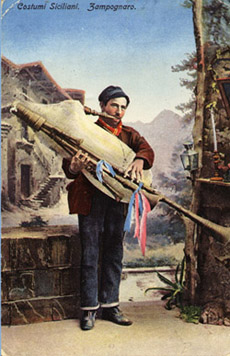|
In Sicily, as elsewhere, the Christian culture and
liturgies have substituted the archaic practises of the winter solstice,
but in spite of the centuries-long action of normalisation implemented
by the Church, it is still possible to catch glimpses of their remote
ancestors in some rituals. First of all, the ones linked to the presence
of propitiatory fires, the zzucchi ‘i menzanotti, the ccippi
(roots, logs or tree trunks), metaphor of the sun that resumes its
rising path (see Buttitta 1985).
Alongside
the existence of celebrative liturgical practises that gel perfectly
with the canons of the prescription of the Church, we can find other
celebratory recitals that are still very much alive, but that actually
move further away from it. This is a varied vocal and instrument
repertoire, but also a dramatic one, which is strictly connected to the
liturgical prescriptions, but at other times, is simply juxtaposed to
them.
|

Player of zampogna a
chiave di Monreale before the votive shrine ('a cona).
Postcard,
1900 ca. (coll. G. Fugazzotto) |
So the
expressions of the popular Sicilian tradition do not exhaust themselves
in the places and in the canonical days of the Christmas time, but are
expressed in parallel to the every day places, making them in some way
sacred, in the street before the sacred images or votive shrines (‘a
cona), or at home before the Bammineddu (the Baby Jesus). The
living presence, furthermore, of the songs linked to the church alms
collection underlines once more the permanence of archaic festive
practices.
Most of these musical performances go by the name of “Novena”, even if
in Sicily this term assumes, as it does elsewhere, a multiplicity of
meanings. Novena is also the name given to the religious function that
is performed for the nine days before Christmas and the singing that
accompanies it. In common usage, then, the term designates both the
narrative song subdivided into nine parts corresponding to the nine days
of the religious function and the songs with a different formal
structure but that are performed within the same celebratory context.
Novena is also the name given to some pieces for zampogna or for small
instrumental groups. |
Wanting to offer an overview of the Christmas
sonorous musical tradition in Sicily here we shall try to outline the
variety of the repertoire, in an attempt to identify the main forms of
rendition:
|
Novena 1. Vocal-instrumental
suite that comprises an introduction performed by a small
ensemble of instruments (generally strings and guitar, but
also instruments of bands), the singing of the Litanies, the
story or the narrative song about the events of the
nativity, an instrumental finale;
Novena 2. Narrative song
subdivided into nine parts corresponding to the nine days
preceding Christmas;
Novena 3. Songs of various
formal structures dedicated to the Madonna or to saint
Joseph;
Novena 4. Also called
Nannaredde or Ninnaredde, vocal or
vocal-instrumental, these are the lullabies to the Baby
Jesus;
Novena 5. Pieces for zampogna or
for small instrumental groups;
Pastorale. Instrumental piece
that follows the Novena of type 5 but that can also be
performed independently of it; it nearly always coincides
with the theme of Tu scendi dalle stelle of Saint
Alphonsus Maria de’ Liguori;
Songs for the alms collection.
Vocal pieces or vocal-instrumental performed at home to
bring greetings and to request in exchange small gifts,
generally foodstuffs to be eaten later on.
Different sonorous rituals such
as the Pasturedda of Antillo (ME) for bells and
bagpipes, the Naca or Bamminu at Isnello (PA)
performed by five bells, the usignolo (the swallow)
of San Marco d’Alunzio (ME) performed with the homonymous
whistle made from reeds during the solemn Christmas midnight
mass.
Dramatic action.
Forms deriving from the ecclesiastical Pastorals that enact
the events of the Nativity or the arrival of the Wise Men,
such as the Pasturali of Licata (AG) or the
Pasturatu of Rodý Milici (ME), or the descendants of the
archaic propitiatory agro-pastoral rituals connected with
the winter solstice, as in the case of the Pastoral of Santa
Elisabetta (AG). |
|
